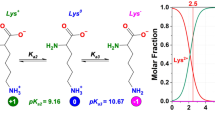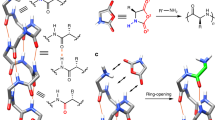Abstract
Combinations of chiral ligands with metal ions are very promising for constructing artificial architectures that lead to functional spaces, such as those widely found in biological systems. Previously, expanded poly(l-amino acid) derivatives have been reported to form unique helical structures, depending on the side chain in the crystal. Herein, silver(I) ions in nonpolar solvents were used to polymerize expanded l-lysine and l-ornithine derivatives. Introducing a bulky hydrophobic acyl group into the terminal amino group of the side chain increased the solubility of the amino acid in chloroform. Polymerization proceeded via the formation of head-to-head and tail-to-tail linkages. 1H diffusion-ordered NMR spectroscopy (DOSY) was used to determine the structures of the oligomeric products. Circular dichroism measurements and density functional theory calculations were then used to estimate the overall secondary structures, which were significantly different from each other despite the small difference, namely, with or without the fourth CH2 moiety.
This is a preview of subscription content, access via your institution
Access options
Subscribe to this journal
Receive 12 print issues and online access
$259.00 per year
only $21.58 per issue
Buy this article
- Purchase on Springer Link
- Instant access to full article PDF
Prices may be subject to local taxes which are calculated during checkout









Similar content being viewed by others
References
Leong WL, Vittal JJ. One-dimensional coordination polymers: complexity and diversity in structures, properties, and applications. Chem Rev. 2011;111:688–764.
Uemura K, Kumamoto Y, Kitagawa S. Zipped-up chain-type coordination polymers: unsymmetrical amide-containing ligands inducing β-sheet or helical structures. Chem Eur J. 2008;14:9565–76.
Khlobystov AN, Blake AJ, Champness NR, Lemenovskii DA, Majouga AG, Zyk NV, et al. Supramolecular design of one-dimensional coordination polymers based on silver(I) complexes of aromatic nitrogen-donor ligands. Coord Chem Rev. 2001;222:155–92.
Adarsh NN, Dastidar P. Coordination polymers: what has been achieved in going from innocent 4,4’-bipyridine to bis-pyridyl ligands having a non-innocent backbone? Chem Soc Rev. 2012;41:3039–60.
Zhang ZY, Deng ZP, Huo LH, Zhao H, Gao S. Well-designed strategy to construct helical silver(I) coordination polymers from flexible unsymmetrical bis(pyridyl) ligands: syntheses, structures, and properties. Inorg Chem. 2013;52:5914–23.
Sawada T, Matsumoto A, Fujita M. Coordination-driven folding and assembly of a short peptide into a protein-like two-nanometer-sizes channel. Angew Chem Int Ed. 2014;53:7228–32.
Sawada T, Yamagami M, Akinaga S, Miyaji T, Fujita M. Porous peptide complexes by a folding-and-assembly strategy. Chem Asian J. 2017;12:1715–8.
Saito A, Sawada T, Fujita M. X-ray crystallographic observation of chiral transformations within a metal-peptide pore. Angew Chem, Int Ed. 2020;59:20367–70.
Misra R, Saseendran A, Dey S, Gopi HN. Metal-helix frameworks from short hybrid peptide foldamers. Angew Chem, Int Ed. 2019;58:2251–5.
Dey S, Misra R, Saseendran A, Pahan S, Gopi HN. Metal-coordinated supramolecular polymers from the minimalistic hybrid peptide foldamers. Angew Chem, Int Ed. 2021;60:9863–8.
Sawada T, Inomata Y, Shimokawa K, Fujita M. A metal-peptide capsule by multiple ring threading. Nat Commun. 2019;10:5687.
Sawada T, Saito A, Tamiya K, Shimokawa K, Hisada Y, Fujita M. Metal-peptide rings form highly entangled topologically inequivalent frameworks with the same ring- and crossing-numbers. Nat Commun. 2019;10:921.
Inomata Y, Sawada T, Fujita M. Metal–peptide nonafoil knots and decafoil supercoils. J Am Chem Soc. 2021;143:16734–9.
Okamura T. Crystal structures of expanded poly(l-leucine) isomers containing bis(pyridine)silver(I) moieties: precise formation of secondary structure depending on the side chain. Chem Eur J. 2018;24:13437–40.
Okamura T, Tsubouchi K, Onitsuka K. Zigzag-helix transformation of expanded polyvaline induced by racemization. Chem Asian J. 2019;14:2950–2.
Hasenaka Y, Okamura T, Tatsumi M, Inazumi N, Onitsuka K. Behavior of anionic molybdenum(IV, VI) and tungsten(IV, VI) complexes containing bulky hydrophobic dithiolate ligands and intramolecular NH···S hydrogen bonds in nonpolar solvents. Dalton Trans. 2014;43:15491–502.
Okamura T, Furuya R, Onitsuka K. Regulation of the hydrolytic activity of Mg2+-dependent phosphatase models by intramolecular NH···O hydrogen bonds. J Am Chem Soc. 2014;136:14639–41.
Okamura T, Kaga T, Yamashita S, Furuya R, Onitsuka K. Snapshot of oxidation of thiolate by diiodine: stabilization of intermediate by NH···S hydrogen bonds. J Org Chem. 2017;82:2187–92.
Frisch MJ, Trucks GW, Schlegel HB, Scuseria GE, Robb MA, Cheeseman JR, et al. Gaussian 09 (Revision C.01), Gaussian, Inc., Wallingford CT, 2010.
Flory PJ. Molecular size distribution in linear condensation polymers. J Am Chem Soc. 1936;58:1877–85.
Chu Q, Swenson DC, MacGillivray LR. A single-crystal-to-single-crystal transformation mediated by argentophilic forces converts a finite metal complex into an infinite coordination network. Angew Chem Int Ed. 2005;44:3569–72.
Lin P, Henderson RA, Harrington RW, Clegg W, Wu CD, Wu XT. New 1- and 2-dimensional polymeric structures of cyanopyridine complexes of agi and cuI. Inorg Chem. 2004;43:181–8.
Li FF, Ma JF, Song SY, Yang J, Liu YY, Su ZM. Influence of neutral ligands on the structures of silver(I) sulfonates. Inorg Chem. 2005;44:9374–83.
Li FF, Ma JF, Song SY, Yang J, Jia HQ, Hu NH. Syntheses, structures, and characterizations of four new silver(I) sulfonate coordination polymers with neutral ligands. Cryst Growth Des. 2006;6:209–15.
Hsiao HL, Wu CJ, Hsu W, Yeh CW, Xie MY, Huang WJ, et al. Diverse Ag(I) complexes constructed from asymmetric pyridyl and pyrimidyl amide ligands: roles of Ag⋯Ag and π–π interactions. CrystEngComm. 2012;14:8143–52.
Sinnwell MA, Baltrusaitis J, MacGillivray LR. Combination of argentophilic and perfluorophenyl-perfluorophenyl interactions supports a head-to-head [2 + 2] photodimerization in the solid state. Cryst Growth Des. 2015;15:538–41.
Chen CH, Cai J, Feng XL, Chen XM. Assembly via H-bonds and Ag–Ag attractions of one-dimensional silver(I) complexes of nicotinamide and nicotinic acid with sulfonate counter-anions. Polyhedron. 2002;21:689–95.
Acknowledgements
This work was supported by the Analytical Instrument Facility, Graduate School of Science, Osaka University.
Author information
Authors and Affiliations
Corresponding author
Ethics declarations
Conflict of interest
The authors declare no competing interests.
Additional information
Publisher’s note Springer Nature remains neutral with regard to jurisdictional claims in published maps and institutional affiliations.
Supplementary information
Rights and permissions
About this article
Cite this article
Okamura, Ta., Tsubouchi, K., Okada, A. et al. Polymerization of expanded l-amino acids containing terminal pyridyl groups by silver(I) ions in nonpolar solvent. Polym J 54, 883–891 (2022). https://doi.org/10.1038/s41428-022-00645-9
Received:
Revised:
Accepted:
Published:
Issue Date:
DOI: https://doi.org/10.1038/s41428-022-00645-9



